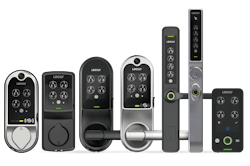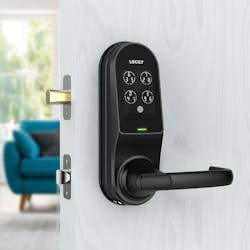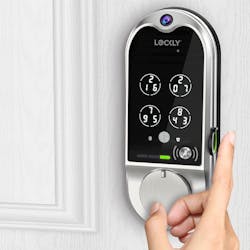It’s possible that you’ve heard the name Lockly by now.
The company came into the U.S. market roughly four years ago and has made its name in the DIY residential market largely through the high-tech innovations it put in its line of smart electronic locks. The most notable is the company’s unique and patented scrambling-number touchscreen keypad.
Not content with playing in the big-box or online retail world, at the start of 2021 Lockly announced plans that would bring their products to the security pro through standard distribution channels. That led to the creation of the Lockly Pro division.
Jim Conti, head of sales for Lockly Pro, says it was a natural progression for the company.
“A lot of folks started to say, ‘hey, could you make [your lock] for multifamily?’” he says. “In addition, Lockly took a look at the market and said, ‘where's the growth? Where’s the market going, and who is in need of these types of innovations?’”
By the time you read this, a “full line” of Lockly Pro locks and access control solutions under the Guard line should be at Banner Solutions, IDN and Top Notch Distributors, Conti says. Lockly Pro expects to have the following Guard products available right away:
- The Deadbolt, and a Z-Wave version of the Deadbolt
- The Duo interconnected lock
- The Defender narrow-stile latch or thumbturn sets
- The Vision video doorbell
- The Latch lever lock
- The Athena swinging- and sliding-door locks
- The Ingress credential reader and doorbell
- Vision versions of the Duo and Ingress
“We would be able to just about cover every door in every residential, multifamily and mixed-use application,” Conti says.
The Pro Move
The Guard name is meant to distinguish between Lockly Pro’s offerings and those Lockly products aimed at the retail market, which will carry the Secure name. Some of the products have similar names, and with the PIN Genie touchscreen on both, they look similar, but the Guard line has been enhanced physically to handle the type of abuse not required for residential locks.
The physical upgrade was necessary to be able to pass requirements several states have for multifamily locks and, Conti acknowledges, to satisfy demand from the professional market. “The locksmith needs a little bit higher quality than what you might need as [a consumer performing] DIY in your own home.”
Further products are expected to continue that upgrade, including a Grade 1 product potentially in 2023 along with “other certification levels for different applications,” Conti adds. For example, those would include improved waterproof capability for exterior products.
One thing that didn’t change in the product upgrade, however, was the ease of installation. Green says all of Lockly’s locks use a standard 161 door prep, with field-adjustable handing, and he would expect an experienced locksmith to be able to install one on a typical door in 15–20 minutes.
“The only exception to that, of course, is the standard mortise implementations,” Conti says. “All the same simplicity that Lockly brings to the other [locks] are still in the mortise versions, but just by the nature of mortise, it does require [more] door prep to be installed.”
Nevertheless, Lockly Pro will provide training. As of press time, it was in the process of building up an online “Lockly University” that would include video as well as step-by-step instructions for installation, and Green adds that the training also eventually would be performed in person.
“You will start seeing us,” he says. “We’re going to be doing counter days with distributors, partners that we’re working with, so that’ll be another option for training.”
One place you won’t see Lockly Pro and the Guard line in particular is online at e-commerce sites, unlike the Secure line that Lockly pitches to retailers.
“We’ve done a very good job getting our ‘e-com’ cleaned up to the point where there’s not going to be any issue for [locksmiths] from a price-erosion type of situation,” Conti insists. “The Guard line was designed to allow them to get a product line that they could make money [from] and get it through their normal distribution channels.”
Going High Tech
Obviously, the burgeoning multifamily market is one that Lockly Pro has targeted for its Guard line, and the Guard line includes high-tech features aimed squarely at that market, including remote access control and credential management.
“In the basic case today, you have to go to every lock and enter your fingerprint into the memory,” Conti explains. “With Air Transfer, we now have this ability to take that scanned metadata of the fingerprint as the property manager to transfer that to any door under my management.”
This capability is on every lock in the Lockly Pro Guard lineup, including the Ingress reader, on the side or the exterior lock face.
Of course, the most notable technical feature of every Lockly lock, pro or otherwise, is the PIN Genie touchscreen keypad.
Unlike a typical keypad, the 10 basic digits — zero through nine — and two repeated numbers are arranged on a Lockly lock keypad in four groups of three numbers each, or 12 total numbers on the keypad. In PIN Genie mode, the numbers are scrambled. After a successful PIN code is entered, the numbers reorient, with only the 10 basic digits appearing in some arrangement each time. (The keypad also can be set so the numbers appear in logical order, with the first group listing 1, 2 and 3 and so forth.)
PIN Genie mode prevents anyone from guessing the code based on watching the location of your finger pressing the keypad, because it changes after every use. Three unsuccessful attempts within 5 minutes will disable the keypad until a recognized fingerprint is entered or the correct code is entered twice in a row.
“We don’t talk enough about that,” Conti admits. “It’s such a market differentiator that once you show them that added level of security the PIN genie keypad could bring to a single-family or multifamily environment, the checks in boxes get really easy.”
For more information, go to locklypro.com
About the Author
Will Christensen
Senior Editor
Will Christensen is senior editor at Locksmith Ledger International. He has been an editor and reporter at magazines and newspapers for more than 30 years.


